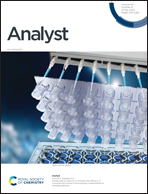A genosensor for detecting single-point mutations in dendron chips after blocked recombinase polymerase amplification†
Abstract
A biosensing system was developed to accurately detect a single nucleotide change in the target organism genome, integrating a selective isothermal amplification and a sensitive dendron-mediated DNA hybridization assay in the array format. The novelty arises from the coupling reactions of the dendron and its use as a crosslinker. The allele-specific probes were oligonucleotide–dendron conjugates prepared by fast and clean click-chemistry (thiol–yne reaction) and coupled onto the photo-activated surface of polycarbonate substrates (carbodiimide reaction). The output was forest-array chips with multipoint-site crosslinkers and compatible with current microarray fabrication technologies. The products of blocked recombinase polymerase amplification (blocked RPA), formed at 37 °C, were hybridized with attached probes for specific nucleotide genotyping. The developed approach exhibited sensitive recognition of DNA variants compared to chips based on linear crosslinkers (10–100 fold), showing excellent analytical performances for planar chip and fluidic formats. The methodology was successfully applied to detect the H1047R mutation in the PIK3CA gene (c.3140A > G) from clinical samples of human cancer tissues, the results being consistent with sequencing techniques. The colorimetric biosensing method was reliable, versatile, low cost, sensitive (detection limit genomic DNA: 0.02 ng μL−1), and specific (accuracy >95%).



 Please wait while we load your content...
Please wait while we load your content...